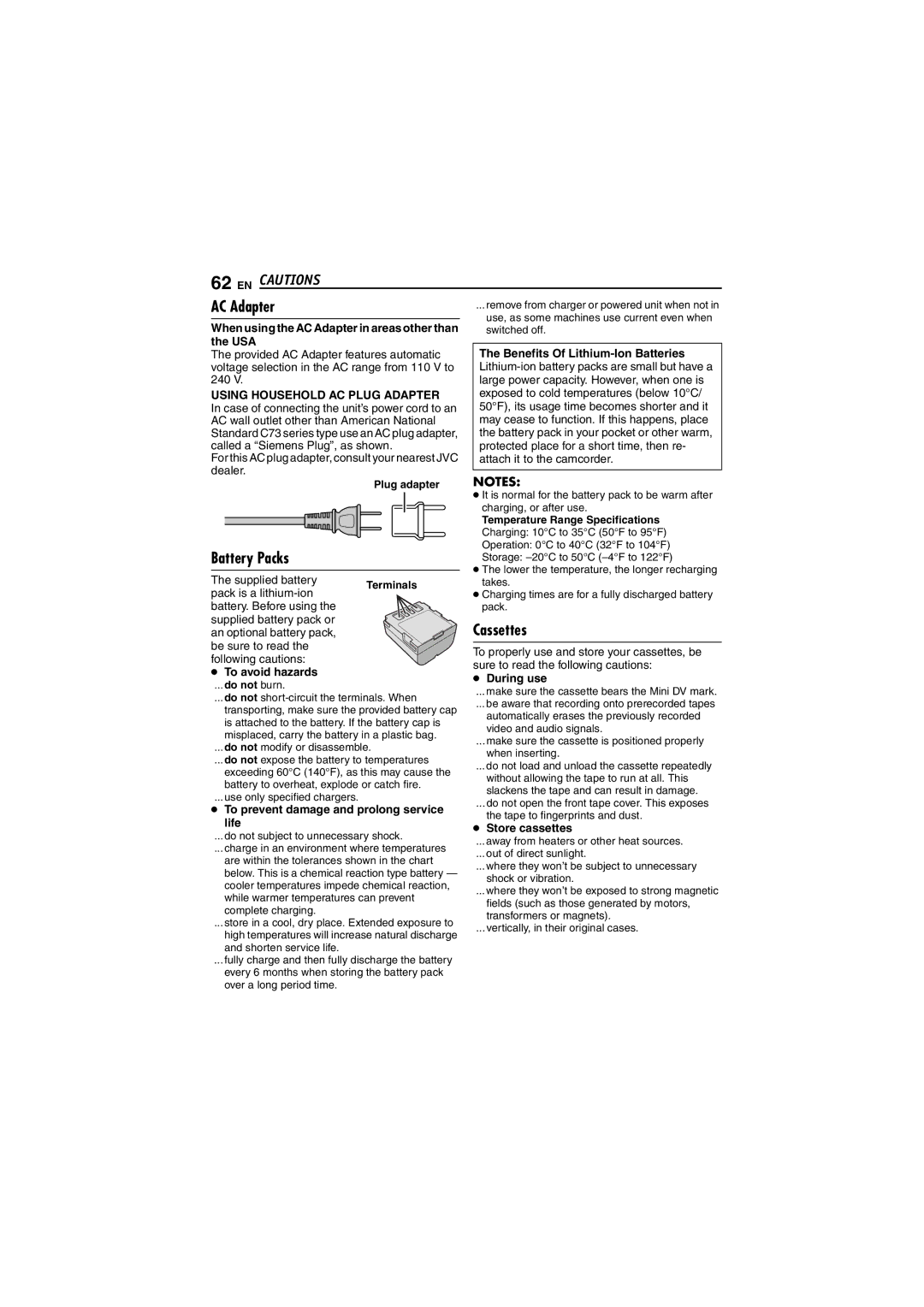
62 EN CAUTIONS
AC Adapter |
|
|
| ... remove from charger or powered unit when not in | |||||||
|
|
|
|
|
|
|
|
|
| use, as some machines use current even when | |
When using the AC Adapter in areas other than | |||||||||||
| switched off. | ||||||||||
the USA |
|
|
|
| |||||||
The provided AC Adapter features automatic |
| The Benefits Of | |||||||||
voltage selection in the AC range from 110 V to |
| ||||||||||
240 V. |
|
|
| large power capacity. However, when one is | |||||||
USING HOUSEHOLD AC PLUG ADAPTER |
| exposed to cold temperatures (below 10°C/ | |||||||||
In case of connecting the unit’s power cord to an |
| 50°F), its usage time becomes shorter and it | |||||||||
AC wall outlet other than American National |
| may cease to function. If this happens, place | |||||||||
Standard C73 series type use an AC plug adapter, |
| the battery pack in your pocket or other warm, | |||||||||
called a “Siemens Plug”, as shown. |
| protected place for a short time, then re- | |||||||||
For this AC plug adapter, consult your nearest JVC |
| attach it to the camcorder. | |||||||||
dealer. |
|
|
|
| |||||||
Plug adapter |
| NOTES: | |||||||||
|
|
|
|
|
|
|
| ||||
|
|
|
|
|
|
|
|
|
| ● It is normal for the battery pack to be warm after | |
|
|
|
|
|
|
|
|
| |||
|
|
|
|
|
|
|
|
|
| charging, or after use. | |
|
|
|
|
|
|
|
|
|
| Temperature Range Specifications | |
|
|
|
|
|
|
|
|
|
| Charging: 10°C to 35°C (50°F to 95°F) | |
|
|
|
|
|
|
|
|
| |||
Battery Packs |
|
|
| Operation: 0°C to 40°C (32°F to 104°F) | |||||||
|
|
| Storage: | ||||||||
|
|
|
|
|
|
|
|
|
| ● The lower the temperature, the longer recharging | |
The supplied battery |
|
| |||||||||
Terminals |
| takes. | |||||||||
pack is a |
|
|
| ● Charging times are for a fully discharged battery | |||||||
battery. Before using the |
|
|
| pack. | |||||||
supplied battery pack or |
|
|
| Cassettes | |||||||
an optional battery pack, |
|
|
| ||||||||
be sure to read the | To properly use and store your cassettes, be | |
following cautions: | ||
sure to read the following cautions: | ||
● To avoid hazards | ||
● During use | ||
... do not burn. | ||
... make sure the cassette bears the Mini DV mark. | ||
... do not | ||
... be aware that recording onto prerecorded tapes | ||
transporting, make sure the provided battery cap | ||
automatically erases the previously recorded | ||
is attached to the battery. If the battery cap is | ||
video and audio signals. | ||
misplaced, carry the battery in a plastic bag. | ||
... make sure the cassette is positioned properly | ||
... do not modify or disassemble. | ||
when inserting. | ||
... do not expose the battery to temperatures | ||
... do not load and unload the cassette repeatedly | ||
exceeding 60°C (140°F), as this may cause the | ||
without allowing the tape to run at all. This | ||
battery to overheat, explode or catch fire. | ||
slackens the tape and can result in damage. | ||
... use only specified chargers. | ||
... do not open the front tape cover. This exposes | ||
● To prevent damage and prolong service | ||
the tape to fingerprints and dust. | ||
life | ||
● Store cassettes | ||
... do not subject to unnecessary shock. | ||
... away from heaters or other heat sources. | ||
... charge in an environment where temperatures | ||
... out of direct sunlight. | ||
are within the tolerances shown in the chart | ||
... where they won’t be subject to unnecessary | ||
below. This is a chemical reaction type battery — | ||
shock or vibration. | ||
cooler temperatures impede chemical reaction, | ||
... where they won’t be exposed to strong magnetic | ||
while warmer temperatures can prevent | ||
fields (such as those generated by motors, | ||
complete charging. | ||
transformers or magnets). | ||
... store in a cool, dry place. Extended exposure to | ||
... vertically, in their original cases. | ||
high temperatures will increase natural discharge | ||
| ||
and shorten service life. |
| |
... fully charge and then fully discharge the battery |
| |
every 6 months when storing the battery pack |
| |
over a long period time. |
|
